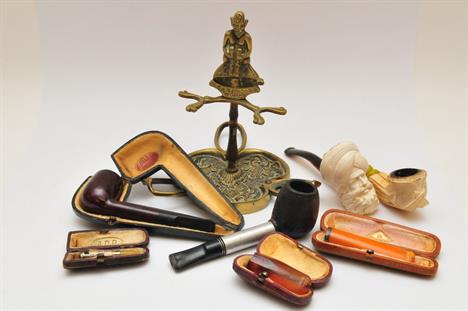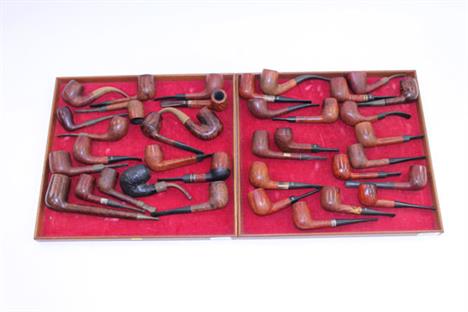We found 43904 price guide item(s) matching your search
There are 43904 lots that match your search criteria. Subscribe now to get instant access to the full price guide service.
Click here to subscribe- List
- Grid
-
43904 item(s)/page
A SAXON HEAVY CAVALRY SWORD, 19th century, the 36"" pipe-backed steel blade etched with foliate scrolls around a Cuirassier crest on one face and Saxon coat of arms on the other, blade inscribed ""EISENHAUER"", nickel plated basket hilt cast with lion head pommel and Saxon coat of arms, initials inscribed upon pommel tip, with wire bound shagreen grip and steel scabbard, 43 1/2"" overall
A FAMILY OF SIX MEDALS FOR WWII awarded to D. Branker, 621 Fd. Sqn. Royal Engineers, comprising 1939/45 Star, Africa Star with 1st Army and oak leaf clasps, France and Germany Star, Italy Star, Defence Medal and War Medal 1939/45, with a pair of woven Desert Rat shoulder flashes, all mounted and framed together, a framed certificate of outstanding good service issued to Mr Branker and signed by Field Marshall Montgomery, dated December 1944, and a photograph of Mr Branker in later life smoking a pipe. Also one volume ""Desert Rats at War"" by George Forty (4)
An interesting single owner collection of shipping items from the schooner sailing ship Kathleen and May which was one of the ships used in in the popular 1970's television series The Onedin Line. Pieces include a caulking, mallet, whistle pipe, Fid Lignum Vitae and Walker's Cherub ship's log, part mounted in wall case. Also sold with this lot, two Merchant Schooner books signed and dated 1970, by the author Basil Greenhill, who was the director of The National Maritime Museum, who bought the Kathleen and May plus related photos and ephemera.
Selection of late 19th/early 20th Century games: McLoughlin Brothers NY `Criss Cross Spelling Slips`, containing 48 x narrow chromolithographed puzzle cards, and Instructions (cards mostly G, in P box); 4 x Arithmetic Puzzles (23cm x 15.5cm, G); Raphael Tuck `Young Riders` containing 6 x pieces (G in P box); Raphael Tuck `Nursery Land` containing 12 x scenic groupings (G-VG in P box). Together with two celluoid animals, a donkey and a cow, length 16cm approx., (both G) and a miniature smoking kit containing a pipe, tobacco pouch, and matchbox (F). (10)
A knitting sheath, 1857, probably beechwood, dated, carved with initials `A W`, two hearts and geometric motifs, 16cm long, and a 19th century mahogany carved pipe, in the form of a horse`s head with a bridle and glass eyes, 9cm long Knitting sheaths were worn on the right-hand side in a sloping position where they held the bottom end of the needle, the top end held by the hand manipulating the wool. Their purpose was to take the weight of the work and to stop stitches slipping off the end of the double-ended needle. They were often carried as love tokens. Sheath: old chips to handle and end. Pipe: both ears missing, damage to forelock, small chip to underside, used.
A miscellaneous collection of items including a 19th century folio containing a quantity of handwritten charters relating to the City of Rochester as set out from the 13th century onwards, a 19th century copy of The Penny Wedding by John Grant, a box containing 1950s and earlier travel ephemera, etc together with a cased 19th century Meeshaum type pipe in the form of an elegant ladies head
A collection of 19th century and other ceramics including an oval majolica bread plate with turquoise and pink colourway, relief moulded dog rose and butterfly decoration and text to the border Waste Not Want Not, a pair of 19th century Staffordshire Spaniels with gilt decoration, a tobacco jar and cover in the form of a seated pipe smoking frog, a collection of Victorian tea wares with painted floral sprays comprising teapot, surcrier and cover, slop bowl, milk jug, four cups and four saucers, Wedgwood green ground jasper wares, two tin glazed earthen ware tiles with painted polychrome decoration of Dutch style characters, a late 19th century Satsuma vase with drawn neck and painted and gilded character decoration, a Victorian pink and gilt cup with aesthetic style decoration, registration mark to the base, etc
10 Britains by First Gear. Zulu War Rorke’s Drift ‘Water Detail’ 24th Foot and Zulu Fight At The Water Cart 20085. 5x Museum Collection- 2x Black Watch Highlander- Indian Mutiny 1857 10002 and Napoleonic Wars 1815 10005. 2x Black Watch Pipes & Drums- Drum Major Early 20thc. 10007 and a Pipe Major Early 20thc 10011. Black Watch Colour Party Ensign With Kings Colour Early 20thc 10019. 4x Napoleonic Waterloo 1815- French Trooper Chasseurs a Cheval 36010, French Empress Dragoons General Louis-Michel Letort 36013. French Chasseurs a Cheval General Charles Lefebvre-desnouettes 36014. Plus The British 42nd (Black Watch) Highlander Standing Firing 36017. All boxed. Contents Mint as new
1934 Mercedes-Benz W25 streamlined record car. Made by John Day. In white metal, painted in silver. Fitted with exhaust pipe, enclosed streamlined cockpit and spoked wheels. VGC-Mint. See Plate 4 Note: In 1934, Rudolf Caracciola succeeds in establishing several class records on the Gyon speed track in Hungary and on the Avus in a modified W 25. On 30th October he establishes a world record, covering a measured mile in 30.71 seconds with a standing start. The performance of the record car was increased to 430hp, its transmission ratios were changed, and its cockpit was equipped with a lining which made Caracciola dub the car the ‘racing limousine’, but apart from that, it had the same design features as a standard W 25 racing car. It achieved a speed of 317.5kmh.
1912 Sunbeam Coupe De L’Auto racing car. In white metal painted in BRG. Nicely detailed with steering wheel, bonnet strap, white painted exhaust pipe, spoked wheels with white rubber tyres. VGC a few small parts loose. See Plate 5 Note: Louis Coatalen was born in Brittany in 1879. In France, he worked for Panhard, Clement and De Dion Bouton. On arriving in England, he worked (purely coincidentally) for Humber and Hillman before joining Sunbeam in 1909. Four Sunbeams were entered for the French Grand Prix and Coupe De L’Auto in June 1912. The cars finished 1st, 2nd and 3rd in the Coupe De L’Auto and 3rd, 4th and 5th in the Grand Prix. Sunbeam instantly became internationally famous. By 1913, Peugeot were dominating racing although a Sunbeam finished 4th at Indianapolis. That year Sunbeam also began to participate in record-breaking.Louis Coatalen “acquired” a Peugeot and studied it closely before designing new cars for 1914. His friend Dario Resta brought the Peugeot to England to show it throughout the country. In Wolverhampton, Resta inadvertently left the Peugeot somewhere convenient for it to be taken to Coatalen’s house. There it was stripped overnight with every significant part being measured and sketched. By morning it had been reassembled. Kenelm Lee Guinness (as in KLG spark plugs) won the 1914 Tourist Trophy in one of the Peugeot-inspired Sunbeams. Motor racing was about to take a backseat, however. With Europe on the brink of war, Sunbeam’s efforts were to be directed elsewhere.
A modern Gurkha double sided pipe banner, of black cloth heavily silver wire embroidered with crossed kukris and scroll inscribed “Gurkha Contingent”, and with gold fringe. New Condition (apparently made for the Edinburgh Tattoo and never used), with a wooden wall plaque decorated with silver coloured crossed kukris from which issues a dummy chanter for displaying the banner; also approximately 75 printed silk cigarette cards, mostly of military badges, 12 large brass buttons with crossed kukris and “Nepal” (some spelt “Nepaul”), 4 small ditto, 12 small with crossed kukris only, and 8 others. Average GC
19th Century French faience horn having continuous blue and white painted foliate decoration and with a panel depicting a romantic couple in a landscape, 37.5cm diameter The last section of pipe near the mouthpiece approximately 15cm in length has been broken off in to four pieces and poorly re-stuck - ** General condition consistent with age
-
43904 item(s)/page






















































